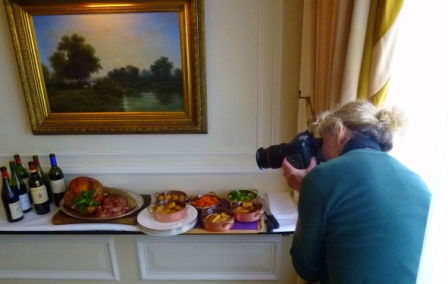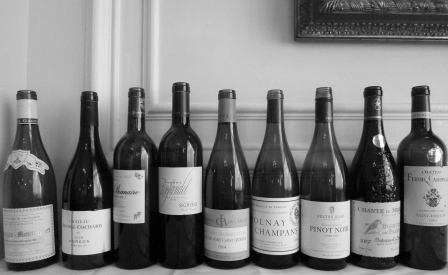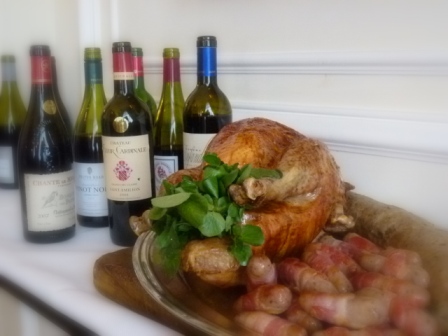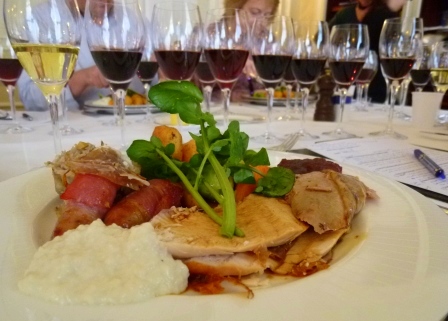Taming the turkey
(by peter)
 In the world of wine, one sure-fire way to know that the height of summer has arrived is when the Christmas barrage starts.
In the world of wine, one sure-fire way to know that the height of summer has arrived is when the Christmas barrage starts.
As we all know, Christmas is the key trading time for many businesses. I was amazed recently to hear how a remarkably high percentage of all wine book sales take place in the festive period. Gifting and indulgence, it seems, is a lifeline for the wine industry. So it’s no surprise that the planning starts early.
Nonetheless, it did feel more than a little odd to be gathering with eminent wine colleagues in sweltering mid-summer London to be tasting Christmas turkey with all the trimmings alongside eight hearty wines. We needed all the imaginative power we could muster to put ourselves at the yuletide table to discover which of the wines would make the best match for the festive feast.
Those gathered in the regally-connected Goring Hotel for this intriguing tasting were Guardian columnist and wine-and-food matcher par excellence Fiona Beckett, wine and food writer Sarah Jane Evans MW, chef and Le Café Anglais proprietor Rowley Leigh, Le Pont de la Tour sommelier Nicolas Clerc MS, and me.
Chef Derek Quelch, a fierce English revivalist according to Leigh, did us proud with a fine bird and traditional accompaniments. Each plate boasted both brown and white meat, carrots, sprouts, roast potatoes, roast parsnips, chipolatas wrapped in bacon, chestnut stuffing, bread sauce and cranberry sauce, all in a rich gravy.
 Before we started, we discussed what wines we all reached for when it came to Christmas lunch. Answers included Chianti, Zinfandel, Chardonnay, Barolo, Viognier, white Châteauneuf-du-Pape, Grenache, Spanish reds, southern French reds, Australian Shiraz, northern Rhône Syrah, Champagne, red Burgundy and New Zealand Pinot Noir.
Before we started, we discussed what wines we all reached for when it came to Christmas lunch. Answers included Chianti, Zinfandel, Chardonnay, Barolo, Viognier, white Châteauneuf-du-Pape, Grenache, Spanish reds, southern French reds, Australian Shiraz, northern Rhône Syrah, Champagne, red Burgundy and New Zealand Pinot Noir.
Clearly, there’s no such thing as a classic Christmas wine. Of course, it’s not always turkey on the table (Leigh favours pork with apple sauce, apparently). And, interestingly, the discussion revealed many personal reasons for choosing certain wines – a prominent family member’s preferences, or a common tradition – which doesn’t necessarily mean the wine is being chosen purely for the food.
Christmas, in short, is about more than just the food-and-wine matching. It was a weighty conclusion…
Levity aside, Susie and I are looking forward to exploring this concept further when we include a classic Christmas turkey dish in this year’s What Food What Wine competition, which is currently being finalised and news of which we’ll be publishing very soon. But, in the meantime, the results of our Goring session were not what you might have expected.
I append my tasting notes and food-matching observations below but, in short, it wasn’t the classed-growth claret or the 1er Cru red Burgundy that triumphed. Nor the Saint-Emilion or the Châteauneuf-du-Pape. Not even the Sonoma Zin or the Central Otago Pinot.
No, it was a white – the beautifully proportioned Chassagne-Montrachet 1er Cru Chenevottes 2004 by Jean-Noël Gagnard.
 Although it wasn’t my top choice (see below for more details), this was undeniably a delicious wine and match. Most importantly, it proved refreshing and moreish with the food – and we all know how heavy the palate and mind can feel even at the start of the Christmas meal. It coped admirably with the range of flavours on the plate and thus proved the consensus favourite.
Although it wasn’t my top choice (see below for more details), this was undeniably a delicious wine and match. Most importantly, it proved refreshing and moreish with the food – and we all know how heavy the palate and mind can feel even at the start of the Christmas meal. It coped admirably with the range of flavours on the plate and thus proved the consensus favourite.
You can read Fiona’s article, published in the December issue of Decanter, by clicking here (this will launch a pdf article as a window in your browser). Incidentally, the odd timing off this piece is due to having to wait to publish until that edition of the magazine had gone off sale.
It’s also worth adding that the range of nine wines on show – just about manageable in the context – was not by any means comprehensive. The limited offering was designed to represent what your average wine lover might plump for – yet it did not include northern Rhône Syrah, Spanish or Italian reds, New World wines outside Central Otago Pinot and Sonoma Zin, Champagne, and other delicacies.
Of course, how each individual wine was showing also had an impact on its deliciousness with the food – for example, the 2003 Volnay showed the brawny, baked character of that vintage, which even a top producer struggled to subdue.
Either way, we went white. So it’s all to play for at What Food What Wine: the Christmas edition. We’d love to hear what your favourite Christmas meal wines are – or equally any disasters. Click here to email us – or leave a comment below.
TASTING
 Chassagne-Montrachet 1er Cru Les Chenevottes 2004, Domaine Jean-Noël Gagnard, 13.5% – restrained, elegant, nutty and spicy. Classic nose, with pleasant age. Matchstick notes. Golden butter. Still a vivid undercurrent of acidity despite the age – no hint of oxidation. Loads of minerality. I’m a big fan of this producer and wine and, while this isn’t my favourite vintage, it’s undeniably delicious. 7.5-8/10
Chassagne-Montrachet 1er Cru Les Chenevottes 2004, Domaine Jean-Noël Gagnard, 13.5% – restrained, elegant, nutty and spicy. Classic nose, with pleasant age. Matchstick notes. Golden butter. Still a vivid undercurrent of acidity despite the age – no hint of oxidation. Loads of minerality. I’m a big fan of this producer and wine and, while this isn’t my favourite vintage, it’s undeniably delicious. 7.5-8/10
…and with the food: very nice with some elements, eg chestnut stuffing, bread sauce etc. But doesn’t engage so well with the bigger, sweeter flavours. Only a partial success for me. My third favourite match.
Morgon Côte du Py 2009, Château Grange Cochard, 13.5% – deep vivid purple hue; young aromas of earthy blackcurrants. Grippy, with youthful juicy fruit, fresh acid and structuring tannin. Brawny still – could do with softening. Pleasantly effusive but unresolved. 7/10
…and with the food: dark, gutsy fruit works surprisingly well. Wine even dominates a bit and comes up hot/raw on the finish as a result. But it’s a really good, slightly surprising match – sweet/sour combo works well. My joint second favourite match.
Felton Road Bannockburn Pinot Noir 2010, 14% – earthy/balsa and plummy aromas. Mint and herbal hints, dark fruit. Spicy, energetic palate. Serious, structured but also fluid and engaging. A bit spicy and hot on the finish, though. 7.5-7/10
…and with the food: A really lovely match flavour-wise – but the alcohol sticks out a mile on the finish. It’s my only criticism but a serious one from my perspective. Makes drinking lots hard – and that’s a consideration at Christmas! But a classy match nonetheless. Maybe another of their wines would have fared better? My joint second favourite match.
Nuits-St-Georges 1er Cru, Les Forets-St-Georges 2004, Domaine de l’Arlot, 13% – much discussion over this wine, which some saw as oddly vegetal. For me it had the classic aromatic markers of the 2004 vintage – the ‘ladybird’ phenomenon, as some have memorably termed it. Dusty, resinous hints, green peas and leather. Mashed red fruit. It’s not for everyone but i’m not averse to this 2004 style. Edgy, but not without appeal. 6.5/10
…and with the food: wine is overwhelmed by the flavours. Comes up thin and metallic. Not a success.
Volnay Champans 1er Cru 2003, Domaine Marquis d’Angerville, 13.5% – muted nose, baked red fruit. Palate is better than nose. Structuring, savoury tannins, earthy and grippy, resolving now. A bit dried but needs food. Touch hot and spicy on finish. Not typical Volnay – expect silk and scent – and instead get brawn and sinew. But as a wine it’s better than expected. 6.5/10
…and with the food: fares much better than the NSG – I really quite like how this works. Understated yet resonant with the dish. A classic match. Refreshing, really engages with all aspects of the dish to make each mouthful better than the sum of its parts. So ends up being my favourite match! But I was on my own with this one…
 Château Branaire-Ducru 2000, St Julien, 13% – elegant notes of tobacco and red/black fruit. Classic and elegant. Good balance of fruit and savoury tannin. Elegantly resolved, with life in it yet. Has enough to it to stand a decent chance with the turkey. 8/10
Château Branaire-Ducru 2000, St Julien, 13% – elegant notes of tobacco and red/black fruit. Classic and elegant. Good balance of fruit and savoury tannin. Elegantly resolved, with life in it yet. Has enough to it to stand a decent chance with the turkey. 8/10
…and with the food: lovely wine – comes up very fresh and a bit austere with the food, though. Might appeal to those with a traditional taste. But it lacks the generosity to really go well. But a lovely side-order nonetheless! My fourth favourite.
Château Fleur Cardinale 2008, Saint-Emilion, 14% – plummy, caramel aromas. Spicy and rich on the palate. Quite a modern style, not to my personal taste but many will like it. 6/10
…and with the food: An inelegant, awkward combination. The wine is too modern. Glossy and slightly sweet edge doesn’t work, funnily enough. Just a moderate, slightly bland match.
Châteauneuf-du-Pape 2007, Chante le Merle, Bosquet des Papes, 14.5% – baked fruit and herbs. Rich and spicy. A bit spirity. And too hot on the finish. 5.5/10
…and with the food: Again, a bit too spirity and exaggerated. Lacks the generosity I’d like to see here. Doesn’t work.
Seghesio Sonoma County Zinfandel 2009, 15.5% – aromas of bubblegum, cream and mashed blackberry fruit. Rich and voluptuous – but very well balanced given the power. Well grounded with some grippy tannin and fresh acidity. 6.5-7/10
…and with the food: Not bad at all. Definitely generous enough – doesn’t get overwhelmed. But comes up a bit simple, almost like white Zin. A simple option for those who like it.
Postscript: many thanks to Decanter/IPC for the kind permission to reproduce their article in pdf format here.
